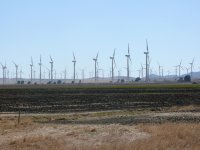No, two wrongs don't make a right, you're exactly right. So do two (or more) badly sited windfarms make all windfarms bad? Of course not.
There have, no doubt, been some well documented, badly located windfarms with terible consequences for birds (mostly raptors), but to say that all windfarms are bad for birds is surely niave?
I'd have said that the proposed road through Białowieża forest in Poland would be a disaster for wildlife. So should we ban all road construction?
As Capercaillee says, each site should be assessed on individual merits and based on data regarding bird activity on and around the wind farm site. This is a pre-requisite of any windfarm application in the UK and that's why we have so far had so few bird-windfarm problems here.
I now make my living undertaking detailed assessments of sites for windfarms (for birds, bats and other wildlife), so am speaking from experience. I'm also a lifelong birder and a passionate conservationist (before anyone accuses me of selling my sole to the devil, ask yourself what sort of people should be undertaking these appraisals).
I have looked at dozens of potential windfarm sites on behalf of developers in order to identify bird issues at an early stage. In most case, though admittedly not all, the developers do not proceed with sites that are likely to be problematic. Firstly, it will be expensive for them to undertake several years of intensive survey and secondly, there is a high risk of failing to obtain planning permission due to opposition by Natural England/Scottish Natural Heritage/CCW and the RSPB. In most cases the commercial risk is simply too high to continue with a controversial site, its only the few bad ones (like Lewis) that we generally hear of, and I have objected to those too.
I always feel for the RPSB when I read the (endless) anti-windfarm letters in the birding media. Their attitude is spot-on for this issue; they don't object to the majority og benign applications, but if they are not happy on a site they fight tooth and nail (believe me, I have first hand experience).
So before jumping on the anti-windfarm bandwaggon, ask yourself this. How much evidence is there of real problems in the UK? Very little. You can come up with conspiracy theories if you like, but the truthis that the British windfarm industry, in the main, have acted responsibly on this issue and should be congratulated for doing so.
As a final point, I think it would be fair to say that many opponents of wind farms cite birds as an issue not because of any genuine concern for birds, but because it is another piece of mud to sling against a development that they do not lile for personal reasons.
Criticism based on evidence is fair and appropriate, but quoting spurious data doesn't help anyone.




